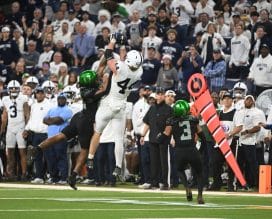Flyers
Biggest Takeaway of 2023-24 Flyers Season: How They Missed the Playoffs

Tuesday night’s season finale for the Flyers was certainly a far cry from the previous season. In 2022-23, the season was essentially over by Thanksgiving. Everything after the trade deadline seemed rather meaningless. Games like that provide no juice, making it a struggle to find motivation to play them at all.
That is where the Flyers deserve credit for the 2023-24 season. This team was scrappy. It knew it didn’t have the talent that others do, but scratched and clawed their way into playoff contention when no one gave them much of a chance.
It’s what made the final result sting so much.
As time was winding down on the Flyers finale against the Washington Capitals, the Flyers were mere seconds away from getting a desired result in Montreal. Detroit scored to tie the game with 3.3 seconds remaining in the third, as the Flyers had about four minutes remaining in regulation of their own game. In one fell swoop, the season and the Flyers playoff hopes were over before their finale came complete.
In reality, the Flyers fate this season had been sealed long before puck drop on Tuesday. They were sitting in the driver’s seat with 11 games to go. That was after play on March 23, when the Flyers dramatically beat the Boston Bruins in the eighth game of a 10-game gauntlet that featured nine playoff teams. From that point on, the team lost the next eight games, only two beyond regulation, and closed out the season with back-to-back wins before Tuesday’s regulation loss by unique standards – the game-winning goal was an empty-net goal scored in a tie game.
During that eight-game streak, you could steal the title of the production that won Best Picture at the 2022 Academy Awards for the highlight film: Everything, Everywhere, All At Once.
The Flyers goaltending was on the decline with the heavy usage of Sam Ersson following Carter Hart’s leave of absence and the lack of an emerging backup to provide similar balance. The defense battled multiple injuries, heavy workloads for the top pairing of Travis Sanheim and Cam York, and lost its sense of structure. The offense dried up collectively over the final weeks. Sean Couturier had one goal and seven points in the final 28 games. Joel Farabee had five goals and 10 points in the final 32 games. Cam Atkinson finished the season on a 21-game streak without a point. It left a lot in the hands of Travis Konecny, Owen Tippett, Scott Laughton, Morgan Frost, and Tyson Foerster, and while they had mostly solid second-half numbers, that eventually dried up too.
It wasn’t only in the timing that everything went wrong, but the quality of opposition too. After playing seven playoff teams in a row, the Flyers final nine games featured only three playoff teams, two of which were still fighting for spots right alongside the Flyers at the time. Four of the other six games were against teams ranked 27th or lower in the league standings.
You can throw out that the Flyers weren’t expected to be in this position – and they certainly weren’t – but they only have themselves to blame for how it all ended. The opportunity was in front of them, and they couldn’t get the job done.
For 71 games, the Flyers had positioned themselves for an unlikely playoff appearance. They defied all expectations, regularly defeated the top competition in the NHL, and did it in a scrappy way that was endearing to the fans. They delivered a level of play that fully explains how they went from 75 points a season ago to a 12-point increase this season. They may also have more answers to what can make up their future as the rebuild progresses.
When such a collapse happens, everyone is left looking for reasons, looking for the why behind the questions that start with how. You could rattle off reason after reason, and try as you may to dismiss it, it would be a contributing factor.
GM Danny Briere remained focused on the rebuild by trading Sean Walker, the team’s most consistent defenseman, at the deadline. The penalty kill and defensive structure started to wither after that. John Tortorella tried playing the usual cards in a playoff run, right down to the regular benchings of players he felt were underachieving, including the newly-named captain Couturier. The prior usage of players, like Couturier or the defensive pairing of Sanheim and York or the constant 11-forward, seven-defensemen lineups, was also starting to catch up with the team’s high-intensity style of play.
Simply put, when something like this happens, everyone can look in the mirror and be accountable for the reasons it happened.
It will define much of this season, overshadowing a lot of the good done over the first 71 games. It will also be their challenge to come back from this, to continue to shape the roster into the contender they want to be, and to be better when the chips are down at the most critical time of the season.





